#עָמַד
Explore tagged Tumblr posts
Text
the aaronide high priest holds the urim and the thummim, then sets each into the fabric near his chest (exodus 28:30). the referents of these are foreclosed from the narrative—their form and function are not named. nonrepresentable, these things of priesthood might help with exstispicy and viscera studies, might make sense of omens (saul seems to think so, at least). to nehemiah, they serve the verb עָמַד as holy reminder. the historian suggests they fit into one another and fit, in turn, only into levitical flesh. the urim and the thummim are fatal remainders of a narrative not explained so much as it is held, or, fisted into chests
8 notes
·
View notes
Text
I just want to say to my fellow Kal that as we are besieged with hatred on sides and there are many moments I find myself thinking this is how it must have felt for during the generations that lived certain times one thing I find myself taking comfort in is knowing that no matter how bad it gets in the end they will fail.
They will always fail just as they always have and we will survive.
For as we sing every year on Pesach
וְהִיא שֶׁעָמְדָה לַאֲבוֹתֵיֽנוּ וְלָנֽוּ. שֶׁלֹא אֶחָד בִּלְבָד, עָמַד עָלֵיֽנוּ לְכַלּוֹתֵנֽוּ. אֶלָּא שֶׁבְּכָל דּוֹר וָדוֹר, עוֹמְדִים עָלֵיֽנוּ לְכַלּוֹתֵנֽוּ. וְהַקָּדוֹשׁ בָּרוּךְ הוּא מַצִּילֵנוּ מִיָּדָם
And this is what kept our ancestors and what keeps us surviving. For not only one arose and tried to destroy us, rather in every generation they try to destroy us and the Holy One Blessed Be saved us from their hands.
They may try, but they shall always fail.
Am Yisrael Chai עַם יִשְׂרָאֵל חַי
4 notes
·
View notes
Text
Hebrew Primer Unit ה Exercise ג
Read the following sentences aloud and translate
.דָּוִד זָכַר. .עָמַד אַבְרָהָם .שָׂרָה עָמְדָה .אָב שָׁמַר .הַנַּעֲרָה שָׁמְרָה .שָׁמְעָה הָאִשָּׁה .רוּת זָכְרָה .הוּא הָלַךְ .הִיא הָלְכָה
1 note
·
View note
Note
I am not spiritual by any means. I do not know for certain that there exists anything metaphysical at all!
Let me tell you it's been a rough road as an Orthodox Jew living with those attributes. There are times when I believe and times when, I'm ashamed to say, I don't.
Most of the time I'm somewhere in the middle, but one of the times when I feel most sure in my religious practice is when thinking of our suffering.
There's a story in the Gemara* (here paraphrased) about a group of rabbis at the ruins of the Holy Temple. When they saw a fox come out of the Holy of Holies, all but one started crying, when the others saw Rabbi Akiva laughing, of all things, they asked him why.
He answered that it had been prophesized that Jerusalem would be destroyed, overgrown, like a forest where foxes roam.
That it had also been prophesized that Jerusalem would be rebuilt and its people would return. That it would be full of life again, with men and women living to old age and children playing in the streets.
Every year at the Passover Seder we sing Vehi Sheamda, which is a poem that does for me what that fox did for Rabbi Akiva.
I hope that after reading it you'll see why.
וְהִיא שֶׁעָמְדָה לַאֲבוֹתֵיֽנוּ וְלָנֽוּ
שֶׁלֹא אֶחָד בִּלְבָד, עָמַד עָלֵיֽנוּ לְכַלּוֹתֵנֽוּ
אֶלָּא שֶׁבְּכָל דּוֹר וָדוֹר, עוֹמְדִים עָלֵיֽנוּ לְכַלּוֹתֵנֽוּ
וְהַקָּדוֹשׁ בָּרוּךְ הוּא מַצִּילֵנוּ מִיָּדָם
And it stands for our forefathers as it does for us
That not only one has risen to destroy us
But in every generation they rise to destroy us
And The Holy One, Blessed Be He, saves us from their hands
Sorry this is kind of a heavier question, but. Religious/theistic Jews, how do you still believe in G-d? I desperately want to believe, but it's getting harder lately. My grandfather became an atheist when he saw what happened in the camps. My mother was religious until she started dating my dad, who apparently logic'd so hard he ruined religion for her. Most of my friends are atheists. It seems like I'm the only one that isn't, but I don't know. The idea that G-d has a plan is really comforting, but it seems impossible. How could He let all these things happen? I feel like G-d either doesn't exist, or He abandoned us. And yet, I still pray and thank Him and it feels so wrong to *not* do any Jewish rituals. Do any of you ever feel like this?
.
#fuzzytheduck#jumblr#jewish#frumblr#judaism#antisemitism#jewblr#jewish stuff#*Talmud#*Makkot 24b if youre interested
80 notes
·
View notes
Text
learning some basic Hebrew so I am translating such brilliant sentences as "אַבְרָהַם עָמַד" (Abraham stood) and "םַלַךְ דָּוִד" (David ruled) and "הַנַּעַר זָכַר" (The young man remembered).
1 note
·
View note
Text
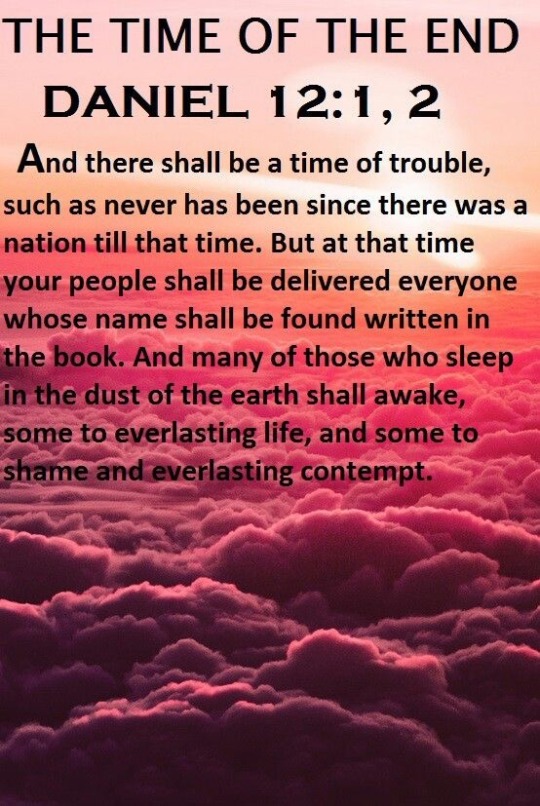
Proof that Daniel 12.1 is Referring to a Resurrection from the Dead Based on Translation and Exegesis of the Biblical Languages
By Author Eli Kittim
Dan. 12.1 is in the context of the great tribulation of the end times! It’s repeated in Mt. 24.21 as the time of the great ordeal: καιρός θλίψεως (cf. Rev. 7.14).
Daniel Th 12.1 LXX:
καὶ ἐν τῷ καιρῷ ἐκείνῳ ἀναστήσεται Μιχαηλ ὁ ἄρχων ὁ μέγας ὁ ἑστηκὼς ἐπὶ τοὺς υἱοὺς τοῦ λαοῦ σου καὶ ἔσται καιρὸς θλίψεως θλῖψις οἵα οὐ γέγονεν ἀφ’ οὗ γεγένηται ἔθνος ἐπὶ τῆς γῆς ἕως τοῦ καιροῦ ἐκείνου.
The Theodotion Daniel 12.1 of the Septuagint translates the Hebrew word עָמַד (amad) as αναστήσεται, which is derived from the root word ανίστημι and means “shall arise.”
Translation:
At that time Michael, the great prince, the protector of your people, shall arise. There shall be a time of anguish, such as has never occurred since nations first came into existence.
My contention that the Greek word ἀναστήσεται (“shall arise”) is referring to a resurrection from the dead has been challenged by critics. My response is as follows.
The first piece of evidence is the fact that Michael is first mentioned as the one who “shall arise” (ἀναστήσεται; Dan Th 12.1 LXX) prior to the general resurrection of the dead (ἀναστήσονται; Dan OG 12.2 LXX). Here, there is solid linguistic evidence that the word ἀναστήσεται is referring to a resurrection because in the immediately following verse (12.2) the plural form of the exact same word (namely, ἀναστήσονται) is used to describe the general resurrection of the dead! In other words, if the exact same word means resurrection in Dan 12.2, then it must also necessarily mean resurrection in Dan 12.1!
The second piece of evidence comes from the Old Greek Daniel version of the Septuagint that uses the word παρελεύσεται to define the Hebrew word עָמַד (amad), which is translated as “shall arise.”
The OG Daniel 12.1 LXX reads:
καὶ κατὰ τὴν ὥραν ἐκείνην παρελεύσεται Μιχαηλ ὁ ἄγγελος ὁ μέγας ὁ ἑστηκὼς ἐπὶ τοὺς υἱοὺς τοῦ λαοῦ σου ἐκείνη ἡ ἡμέρα θλίψεως οἵα οὐκ ἐγενήθη ἀφ’ οὗ ἐγενήθησαν ἕως τῆς ἡμέρας ἐκείνης.
The OG Daniel version of the Septuagint further demonstrates that Daniel 12.1 is describing a death-and-resurrection theme because the word παρελεύσεται means to “pass away” (to die), thereby indicating the decease of this featured prince at the time of the end! It therefore sets the scene for his resurrection as the so-called “Theodotion Daniel” form of the LXX fills in the gaps by using the word αναστήσεται, meaning a bodily resurrection, to establish the latter day period as the time during which this princely figure will be resurrected from the dead!
#daniel12v1#bible translation#bible exegesis#Biblical Greek#biblical hebrew#resurrection#eschatological resurrection#Daniel Theodotion#Daniel Old Greek#septuagint#lxx#daniel12v2#עָמַד#ἀναστήσεται#ἀναστήσονται#bible commentary#eli kittim#christian eschatology#作者埃利#EK#Author EK#EK Ministries#Eli Kittim Ministries#ministries of Kittim#ministry of kittim#eli of kittim ministry#eli of kittim ministries#eli kittim exegetical system
6 notes
·
View notes
Text
וְהִיא שֶׁעָמְדָה לַאֲבוֹתֵינוּ וְלָנוּ. שֶׁלֹּא אֶחָד בִּלְבָד עָמַד עָלֵינוּ לְכַלּוֹתֵנוּ, אֶלָּא שֶׁבְּכָל דּוֹר וָדוֹר עוֹמְדִים עָלֵינוּ לְכַלוֹתֵנוּ, וְהַקָּדוֹשׁ בָּרוּךְ הוּא מַצִּילֵנוּ מִיָּדָם.
"And She is the One who stood for our forefathers and for us. For it wasn't just one alone that stood over us to exterminate us, but in every generation they stand over us to exterminate us, and the Holy One Blessed be He saves us from their hands"
[From the Pesach Hagaddah]
I know things are looking pretty grim right now, but remember that our ancestors have faced similar situations and nevertheless we have survived. We are unbreakable, in every generation there have been those that have sought to exterminate us, and we are still here today. We may be few in numbers, we may be outnumbered, but we are strong. Our existence is a miracle, whether you believe in miracles or not, and we are stronger together.
#jumblr#with what's been going on the world in the past few weeks#antisemitism#jewish pride#you may notice that two different genders are used for hashem in this passage and yeah there's a lot of meaning to that#jewish resilience#jewish hope
240 notes
·
View notes
Text
שֶׁלֹא אֶחָד בִּלְבָד, עָמַד עָלֵיֽנוּ לְכַלּוֹתֵנֽוּ. אֶלָּא שֶׁבְּכָל דּוֹר וָדוֹר, עוֹמְדִים עָלֵיֽנוּ לְכַלּוֹתֵנֽוּ. וְהַקָּדוֹשׁ בָּרוּךְ הוּא מַצִּילֵנוּ מִיָּדָם
For, not only one arose and tried to destroy us, rather in every generation they try to destroy us, and Hashem saves us from their hands.
#i need this today#the circle is coming back around#hashem matzileinu#hashem yatzileinu#poway shooting#antisemitism#jumblr
27 notes
·
View notes
Text
The Exodus According to Jewish Tradition
PART III: The Faithful Shepherd
Part I Here
Part II Here
So, I am doing a series of posts illustrating Yetzias Mitzrayim (The Exodus from Egypt) according to the Talmud/Midrash. Since the Talmud and Midrash are incredibly vast, I’m going to put some limitations on where I’m going to go, in order to provide a basic story.
In a place where there are multiple interpretations, I intend to bring a basic one in order to keep the flow, as opposed to a convoluted one that implements more complex or deeper methods of biblical exegesis (There are tons of different rules in that, and this is not the time or place to explore them). I may occasionally hint to or explain what the lesson is for us in details of the story, but in general I will try to keep to basic storytelling. In this one, I will discuss the beginning of the Exile and servitude, the birth of Moshe, and Moshe’s upbringing, and how he became the Faithful Shepherd of Israel. The post is super long – writing it in a normal word processor, it was well over 4 pages, so I’m placing it under a read-more.
I will be proceeding in chronological order, but because this post could end up being massive, I will be dividing it up into narrative sections, so I present to you the third one, “The Faithful Shepherd”.
It states in the sedra of Beshalach;
וַתִּקַּח֩ מִרְיָ֨ם הַנְּבִיאָ֜ה אֲח֧וֹת אַהֲרֹ֛ן אֶת־הַתֹּ֖ף בְּיָדָ֑הּ וַתֵּצֶ֤אןָ כָֽל־הַנָּשִׁים֙ אַחֲרֶ֔יהָ בְּתֻפִּ֖ים וּבִמְחֹלֹֽת׃
Then Miriam the prophetess, Aaron’s sister, took a timbrel in her hand, and all the women went out after her in dance with timbrels.
The Midrash Rabbah comments on this:
אָמַר רַבִּי עַמְרָם בְּשֵׁם רַב לְפִי שֶׁהָיְתָה מִרְיָם מִתְנַבֵּאת וְאוֹמֶרֶת עֲתִידָה אִמִּי שֶׁתֵּלֵד בֵּן שֶׁיּוֹשִׁיעַ אֶת יִשְׂרָאֵל, כֵּיוָן שֶׁנּוֹלַד משֶׁה נִתְמַלֵּא כָּל הַבַּיִת אוֹרָה, עָמַד אָבִיהָ וּנְשָׁקָהּ עַל רֹאשָׁהּ, ...אֲחוֹת אַהֲרֹן וְלֹא אֲחוֹת משֶׁה, אֶלָּא שֶׁאָמְרָה נְבוּאָה זוֹ כְּשֶׁהִיא אֲחוֹת אַהֲרֹן וַעֲדַיִן לֹא נוֹלַד משֶׁה,
Rebbi Amram said in the name of Rav: “Because Miriam used to prophecize and say ‘In the future my mother will give birth to a son who will redeem the children of Israel’. When Moshe was born the whole house was filled with [a physical,. Tangible] light. Her father stood up and kissed her upon her head”… “[in this verse she was called] The sister of Aharon and not the sister of Moshe, because she became a prophetess even before Moshe was born.”
After the passing of the founders of the 12 tribes – the last being Levi – whom the Egyptians feared as people capable of transcending the guidelines of nature at an intense level that no amount of sorcery or trickery could achieve, the Jewish people began to truly multiply. As they became many the Egyptians’ hate for them -stemming from their refusal to assimilate and accept Egyptian culture - simmered below the surface, approaching its boiling point.
ויקם מלך חדש אשר לא ידע את יוסף
“A new king arose who did not know Yosef”
The simple meaning being that either a new Pharaoh took over, who pretended not to know of Yosef and what he did for Mitzrayim, or the old Pharaoh decided to establish new decrees against the Jewish people. At this point, Pharaoh decided that he wanted to “deal” with the Jewish people – to decrease their numbers and make use of them as servants. Like all kings, he decided to seek advice – and in this meeting were three advisors in particular; Bila’am, Iyov (Job) and Yisro (who would become Moshe’s father in law). Bila’am advised Pharaoh that he should enslave them, and offered to curse the borders of Mitzrayim so that the Jewish people would be unable to leave. For this, he was punished by the sword (Pinchas would kill him, after they left Mitzrayim).
Iyov remained silent, and for this he was punished with the suffering written in the book of Iyov.
At one point – the midrash relates – Iyov was in such incredible physical pain that he was crying out, yelling at nobody in particular but for his pain. An angel of Hashem came to him and said “Iyov, why are you crying out.”
To this, Iyov answered “Because I am in pain.”
“Does the yelling out help your pain?” asked the Angel
“No, but it is the nature of things that a person cries when they are suffering.” Iyov countered
The Angel replied “If this is the case, why did you remain silent as G-d’s people suffered.”
Yisro spoke out against the plan to enslave the Jewish people, and in the end had to flee Mitzrayim and went to Midiyan (and for this he merited that his children’s children sat in the Great Sanhedrin in Yerushalayim).
Once it was decided that they wanted to enslave the Jewish people, they decided to trick them into beginning work. Pharaoh himself went to Goshen (where the Jews lived) and asked the them to join him in building new cities and storehouses for Mitzrayim, to ensure a future for them and the other people, offering to pay them handsomely in return. Most of the Jews – with the exception of the tribe of Levi – obliged, excited to participate with the King himself in building a future for the country. After a few days, Pharaoh stopped working with them, and soon afterwards began to gradually reduce their pay, and as they became accustomed to work, they were transformed into servants, and the Egyptians placed upon them taskmasters to oversee their labor.
A few years passed by (The year is 2368 on the Hebrew calendar – this year is 5779) and the stargazers and sorcerers of Pharaoh came to him, saying that they discovered through their sorcery that the Redeemer of the Jews would be born that year – but they were not sure whether he would be a Jew or an Egyptian. They also discovered that his downfall will be through water (we know that it would be from hitting the rock for water to come out, when Hashem told him to speak to it, but the Egyptians couldn’t have known that)
ואמר פרעה אל עמו וגו’ ...הבא נתחכמה לו
And Pharaoh said to his people… “Come, let’s be wise with him.”
The Talmud interjects:
להם מיבעי ליה א"ר חמא ברבי חנינא באו ונחכם למושיען של ישראל
[“Come let’s be wise with him”?] It should have said “Come, let’s be wise with them”! Rabbi Chama bar Chanina said “Come and let’s be wise with the savior of Israel”.
במה נדונם נדונם באש כתיב (ישעיהו סו, טו) כי הנה ה' באש יבא וכתיב כי באש ה' נשפט וגו' בחרב כתיב [(ישעיהו סו, טז) ובחרבו את כל בשר]
With what form of death shall we judge and decree upon them? If we shall judge them with fire, perhaps we will be punished measure for measure by fire, as it is written: “For behold, Hashem will come in fire” (Isaiah 66:15), and it is written in the verse that follows it: “For by fire will the Hashem contend” (Isaiah 66:16). Similarly, we cannot judge them with the sword, as it is written in the continuation of that verse: “And by His sword with all flesh” (Isaiah 66:16).
אלא בואו ונדונם במים שכבר נשבע הקב"ה שאינו מביא מבול לעולם שנאמר (ישעיהו נד, ט) כי מי נח זאת לי וגו' והן אינן יודעין שעל כל העולם כולו אינו מביא אבל על אומה אחת הוא מביא
Rather, let us come and judge them with water, by drowning the Jewish babies. God will not punish us with water, for the Holy One, Blessed be He, already took an oath that He will not bring a flood upon the world, as it is stated: “For this is as the waters of Noah unto Me; for as I have sworn that the waters of Noah should no more go over the earth” (Isaiah 54:9). The Talmud comments: And Pharaoh’s advisors did not know that He will not bring a flood upon all the world, but He may bring destruction by water upon one nation.
First Pharaoh spoke to 2 midwives – Shifra and Puah (Whom the Talmud says was either Miriam and Yocheved, or Elisheva – Aharon’s wife - and Yocheved) and told them that any baby boy born should be killed, and every girl can be left alive. However, the midwives’ awe of G-d was greater than their fear of a King of flesh and blood, and rather than killing the male children, they redoubled their efforts to ensure that they would not just live, but that they would be able to live as a Jew, with the proper education and the proper upbringing.
Pharaoh was unhappy with this, and instead spoke to the Egyptians and decreed that every baby boy born – both to the Jews, and to the Egyptians (as they were not sure whether the savior of the Jews would be Egyptian or whether he would be a Jew) should be thrown into the river… And every baby girl should be taken and indoctrinated in Egyptian culture (from The Lubavitcher Rebbe).
Amram – the leader of the generation – decided that if all the jewish baby boys would be thrown into the river, that it wasn’t worth having children whatsoever, so he stood up and divorced his wife, Yocheved. The men of the generation soon followed his example and divorced their wives.
The Talmud continues:
אמרה לו בתו אבא קשה גזירתך יותר משל פרעה שפרעה לא גזר אלא על הזכרים ואתה גזרת על הזכרים ועל הנקיבות פרעה לא גזר אלא בעוה"ז ואתה בעוה"ז ולעוה"ב פרעה הרשע ספק מתקיימת גזירתו ספק אינה מתקיימת אתה צדיק בודאי שגזירתך מתקיימת שנאמר (איוב כב, כח) ותגזר אומר ויקם לך עמד והחזיר את אשתו עמדו כולן והחזירו את נשותיהן
His daughter, Miriam, said to him: Father, your decree is more harsh for the Jewish people than that of Pharaoh, as Pharaoh decreed only with regard to the males, but you decreed both on the males and on the females. And now no children will be born. Additionally, Pharaoh decreed to kill them only in this world, but you decreed in this world and in the World-to-Come, as those not born will not enter the World-to-Come. Additionally, concerning Pharaoh the wicked, it is uncertain whether his decree will be fulfilled, and it is uncertain if his decree will not be fulfilled. You are a righteous person, and as such, your decrees will certainly be fulfilled, as it is stated with regard to the righteous: “You shall also decree a thing, and it shall be established unto you” (Job 22:28). Amram accepted his daughter’s words and arose and remarried his wife, and all others who saw this followed his example and arose and remarried their wives.
With the great celebration, Yocheved – who was 130 years old at the time – was returned to her youthand able once again to have children. At the wedding, Aharon and Miriam danced before their mother, and sang out the verse אם הבנים שמיחה הללוי-ה - “And the mother rejoices with her children, Praise Hashem!”
Six months later, a baby boy was born to them – and the house was filled with light. Yocheved named him Tuviya – to prophecize that he would bring goodness to the Jews and goodness to the world. The Egyptians – who had begun counting Yocheved’s pregnancy from the remarriage, assumed that she would have the baby at 9 months. This allowed her to hide him for 3 months, until the Egyptians came to find him. After 3 months had passed, she placed him in a basket, sealed to be water-tight, and placed him on the river. Miriam, who wanted to know what would happen to her prophecy, followed the basket as it floated down the river, to the royal palace, where Basya – the daughter of Pharaoh – was going down to the river to immerse herself.
The Talmud comments:
תרד בת פרעה לרחוץ על היאור א"ר יוחנן משום ר' שמעון בן יוחי מלמד שירדה לרחוץ מגלולי אביה וכן הוא אומר (ישעיהו ד, ד) אם רחץ ה' את צואת בנות ציון וגו'
“The Daughter of Pharaoh came down to immerse herself in the river” Rebbi Yochanan said in the name of Rebbi Shimon Bar Yochai “We can learn from this that she came down to the river to wash off the idolatry of her father”(i.e. to convert to Judaism) and so it is said “When Hashem will wash off the grime of the daughters of Zion”.
She saw the basket floating down the river and retrieved it – either through a miracle (of her own arm extending) or through natural means (going herself or sending a maidservant to retrieve it). Upon looking inside, she found Moshe wrapped in a tallis – knowing that he was a Jewish baby, she understood that with her conversion to Judaism, G-d had given her the merit of raising a Jewish child in his own tradition. Miriam walked up to the daughter of Pharaoh, and asked if she needed to find a Jewish woman who could nurse the child, and to help begin to teach him the tradition and to teach him of his inheritance – to be a member of what will become a nation of priests, and a holy nation. She named him Moshe – short for “מן המים משתיהו”, “He was drawn from the water” - the name he would be called until this day.
Basya enthusiastically agreed, and even said that she would pay the nurse/teacher for her services. Miriam ran to retrieve Yocheved herself. The Talmud comments about the righteousness of Yocheved; that - because of her incredible merit - not only was her child returned to her, but she was paid to take care of him. She taught him of his tradition, omitting only the sign which the true redeemer must carry – something that was only known to a select few in the generation.
As a small child – a toddler under the age of 3… while Pharaoh himself was holding Moshe, he pulled off the crown from Pharaoh’s head and placed it upon his own head. Pharaoh’s advisers immediately noticed and came to Pharaoh, telling him that it was a sign that in the future, Moshe would come to overthrow him. On that, he was ready to have Moshe killed, but Yisro (still there!) realized that there was no reasoning with Pharaoh, and devised a way to hopefully save Moshe’s life. He proposed that a test be made to see if Moshe was wise, or not. They would put in front of him a bowl of glowing coals, and a bowl filled with gold. If Moshe reached for the gold, it would be a sign that he was a threat to Pharaoh, and if he reached for the burning coals, it would be a sign that he would not threaten the throne. As Moshe was reaching for the gold, the angel Gavriel came and grabbed Moshe’s hand, and directed it into the bowl of coals. Having burned his hand, Moshe pulled his hand back and placed his fingers in his mouth (with little bits of coals), burning his hand, and leaving him with a speech impediment which had plagued him for nearly the rest of his life (Shemos Rabbah)
As Moshe grew up, knowing he was a jew, he was appalled by the Egyptians’ treatment of his brethren. He would walk among them, and whenever he saw a Jew bowing under their load, he would come to them and help them to carry it. If he saw the elders with a load fit for younger people, and loads of the younger fit for the elders, he would switch them. He stood before Pharaoh often and made a case for the Jewish people using logical arguments. For instance – He said to Pharaoh “If a person has a servant and they are given heavy work every day, they are less efficient, they become more tired, and eventually it will shorten the amount of time they can work. Give them all one day a week, one day where they can rest, that they will be able to work at their best the rest of the week.” Pharaoh agreed, and Moshe established the Shabbos for the children of Israel, beginning to teach them the laws and the customs of the day of rest which they would soon be charged with keeping for the rest of all time.
One day, Moshe saw an Egyptian beating a Jew. Upon a bit of investigation, He found out that the Egyptian had violated the Jew’s wife the previous night, and when the Jew had confronted the Egyptian about it, he had begun lashing him, with the intention to kill him. Moshe ran up, and pronounced a divine name, at which point the Egyptian dropped dead. Moshe dug up the sand and hid the Egyptian’s body. However, the Jew in question (a real troublemaker) went to Pharaoh’s court and reported on Moshe’s actions, that he killed the Egyptian, and revealed to the Egyptians where Moshe had hidden the body. Pharaoh decreed the Moshe should be killed. He was taken to the executioner to be beheaded. However, when the executioner brought down his sword on Moshe’s neck, it bounced off and beheaded him (the executioner). Moshe realized it was a sign from G-d and proceeded to flee Mitzrayim, going eventually to Midyan.
He met up with Yisro – the same one who a had stood up for the Jewish people in Mitzrayim, and who had helped to save his life from Pharaoh. He offered to work as a shepherd for Yisro, and was married to Yisro’s daughter, Tzipporah.
One day, while he was shepherding Yisro’s flock, one small lamb wandered away. After making sure that someone was paying attention to the rest of Yisro’s flock, he followed the strayed sheep, which continued to walk until it reached a small wellspring, where it stopped to drink. Moshe said to the lamb with intense feeling and empathy, “I see that you were thirsty, had I known this, I would have brought you to the water.” The intimate care with which Moshe watched Yisro’s sheep, coupled with his love for the Jewish people and his constant involvement – while in Mitzrayim – in trying to make things better for them, demonstrated to G-d that Moshe had become fit to shepherd the Flock of Hashem, the Children of Israel. His care in bringing the sheep to water demonstrated that he was ready to bring Hashem’s sheep to the water – the Torah which is compared to water. G-d pointed and said “This is the Shepherd to whom I will entrust my flock”. and at that moment, G-d called out to Moshe from the Burning Bush.
Thanks for tuning in to this installment of “Yetzias Mitzrayim According to Jewish Tradition”, and look forwards to the next one (which is going to contain a bit of flashback information to fill in this one, but it’s more important in context of what’s coming next).
7 notes
·
View notes
Video
youtube
Pessach Medley with Micha Gamerman (Official Animation Video)
Micha Gamerman
Brazilian singer Micha Gamerman is back with his second animated music video. He released the first this past Purim with a Purim Medley off his latest hit album Moadei Yisrael Im Micha Gamerman. In the four week’s since its release, the animated video garnered over 186,336 views on Youtube alone.
With the fast approaching holiday of Pessach stating next week, Micha released his new video the “Pessach Medley” which is sure to thrill both kids and adults alike. The medley was arranged by the talented duo of Eli Klein and Yitzy Berry. Moadei Yisrael Im Micha Gamerman consists of six medleys, one for each of the major chagim; Purim, Pessach, Shavuot, Yamim Noraim (Rosh Hashana/Yom Kipur), Sukot and Chanuka.
This album has so much energy and flavor that the Chaguim come alive for everyone, both young and old. Moadei Yisrael Im Micha Gamerman is available for purchase at your local judaica store in the US thru distributor MRM Music as well as available for digital purchase on these platforms.
MostlyMusic.com : https://mostlymusic.com/products/mich...
iTunes: https://itunes.apple.com/us/album/moa...
Amazon Music: https://www.amazon.com/Moadei-Yisrael...
Google Play: https://play.google.com/store/music/a...
Follow us: Website: www.michagmusic.com
Fan Page: https://www.facebook.com/MichaGamerma...
Credits: Music Arranged by: Eli Klein & Yitzy Berry
Drums: Avi Avidani
Brass: Rafi Davidov & Sahar Livneh
Guitars: Avi Singolda
Keyboard and Synth: Eli Klein & Yitzy Berry
Mix and Master: Eli Klein & Yitzy Berry
Child Soloist: Yonathan Fried, David Green
Photo: Elki Gamerman
Album Designed: Yossi Zweig
Video and Animation: VemVer Films Production
Songs:
1) קַדֵּשׁ וּרְחַץ כַּרְפַּס יַחַץ מגִּיד רַחְצָה מוֹצִיא מַצָּה מָרוֹר כּוֹרֵךְ שֻׁלְחָן עוֹרֵךְ צָפוּן בָּרֵךְ הַלֵּל נִרְצָה Kadesh, Urchatz, Yachatz, Karpas, Yachatz, Maguid, Rochtza, Motzi-Matza, Maror, Korech, Shulchan Orech, Tzafun, Barech, Halel, Nirtza
2) מַה נִּשְׁתַּנָּה הַלַּיְלָה הַזֶּה ?מִכָּל הַלֵּילוֹת שֶׁבְּכָל הַלֵּילוֹת אָנוּ אוֹכְלִים חָמֵץ וּמַצָּה הַלַּיְלָה הַזֶּה כֻּלּוֹ מַצָּה שֶׁבְּכָל הַלֵּילוֹת אָנוּ אוֹכְלִין בֵּין יוֹשְׁבִין וּבֵין מְסֻבִּין הַלַּיְלָה הַזֶּה כֻּלָּנוּ מְסֻבִּין Ma Nishtana Halaila Haze Mikol Haleilot? Shebechol Haleilot Anu Ochlim Chametz Umatzá, Halaila Haze Kulo Matzá Shebechol Haleilot Anu Ochlim Bein Yoshvin Ubein Messubin, Halaila Haze Kulanu Messubin
3) עֲבָדִים הָיִינוּ, הָיִינוּ עַתָּה בְּנֵי חוֹרִין, בְּנֵי חוֹרִין עֲבָדִים הָיִינוּ עַתָּה, עַתָּה בְּנֵי חוֹרִין, בְּנֵי חוֹרִין Avadim Hayinu, Leparo Bemitzraim, Avadim Hayinu, Ata Bene Chorin
4) אִלּוּ הוֹצִיאָנוּ מִמִּצְרַיִם וְלֹא עָשָׂה בָהֶם שְׁפָטִים דַּיֵּנוּ Ilu Hotzianu Mimitzraim, Velo Assá Bahem Shefatim Dayenu
5) וְהִיא שֶׁעָמְדָה, וְהִיא שֶׁעָמְדָה לַאֲבוֹתֵינוּ וְלָנוּ שֶׁלֹּא אֶחָד בִּלְבַד עָמַד עָלֵינוּ לְכַלּוֹתֵנוּ אֵלָא שֶׁבְּכָל דּוֹר וָדוֹר עוֹמְדִים עָלֵינוּ לְכַלּוֹתֵנוּ וְהַקָּדוֹשׁ בָּרוּךְ הוּא מַצִּילֵנוּ מִיָּדָם Vehi Sheamda Laavoteinu Velanu, Shelo Echad Bilvad Amad Aleinu Lechaloteinu, Ela Shebechol Dor Vador Omdim Aleinu Lechaloteinu, Vehakadosh Baruch Hu Maztlileinu Miyadam
6) ?שְׁלֹשָׁה עָשָׂר מִי יוֹדֵעַ !שְׁלֹשָׁה עָשָׂר אֲנִי יוֹדֵעַ שְׁלֹשָׁה עָשָׂר מִדַּיָּא, שְׂנֵים עָשָׂר שִׁבְטַיָּא אַחַד עָשָׂר כּוֹכְבַיָּא, עֲשָׂרָה דִּבְּרַיָּא תִּשְׁעָה יַרְחֵי לֵדָה, שְׁמוֹנָה יְמֵי מִילָה שִׁבְעָה יְמֵי שַׁבְּתָא, שִׁשָּׁה סִדְרֵי מִשְׁנָה חֲמִשָּׁה חֻמְשֵׁי תּוֹרָה, אַרְבַּע אִמָּהוֹת שְׁלֹשָׁה אָבוֹת, שְׁנֵי לוּחוֹת הַבְּרִית .אֶחָד אֱלֹהֵינוּ שֶׁבַּשָּׁמַיִם וּבָאָרֶץ
Shlosha Assar Mi Yodea? Shloasha Assar Ani Yodea!
Shlosha Assar Midayá, Shneim Assar Shivtayá, Achad Assar Kochvayá, Assará Dibrayá, Tishá Yarche Leidá, Shmoná Yeme Milá, Shivá Yeme Shabtá, Shishá Sidre Mishná, Chamishá Chumshe Torá, Arbá Imahot, Shloshá Avot, Shne Luchot Habrit, Echad Elokeinu, Shebashamaim Uvaaretz
0 notes
Text
Hebrew Basics #5: Verbs, pt. 3: Heavy Verb Stems
Hi everyone!
This lesson I’ll finally be finishing up Hebrew verb stems with the last group of stems: פֻּעַל, פִּעֵל and הִתְפַּעֵל - also called the heavy stems (בִּנְיַנְים כְּבֵדִים binyanim kfvedim) or the double stems (בִּנְיַנְים כְּפוּלִים binyanim kfulim).
The main feature distinguishing them from other stems is a dagesh on the 2nd radical letter, which also gives them their names (note that because ע is a guttural letter it cannot take a dagesh, so it doesn’t appear in the very name of the verb stems - but it’s there). Historically, this dagesh signified gemination, or doubling of a consonant, much like an Arabic shaddah. For instance: כָּתַב ‘(he) wrote’ would be pronounced katav, whereas כַּתָּב ‘reporter’ would be pronounced kattav. These days letters with a dagesh are not pronounced differently than the same letter without a dagesh, but its effect can still be seen - for example in בג״ד כפ״ת, that did not go under ‘softening’ when geminate, and therefore retain their hard pronunciation in verb and noun stems that contain a dagesh.
Now let’s leave the technicalities aside and dive into the verb stems’ individual meanings.
פִּעֵל is one of the most common verb stems in the language, and can take a wide variety of different meanings. From standard active verbs:
דִּבֶּר diber ‘to speak’ סִפַּר siper ‘to tell; to cut hair’ צִלֵּם tsilem ‘to photograph’
To more ‘powerful’ version of equivalent פָּעַל verbs:
שָׁבַר shavar ‘to break’ - שִׁבֵּר shiber ‘to break (purposefully)’ שָׁמַר shamar ‘to save’ - שִׁמֵּר shimer ‘to conserve’ חָשַׁב chashav ‘to think’ - חִשֵּׁב chishev ‘to calculate’
Or even causative verbs, like הפעיל:
גָּדַל gadal ‘to grow’ - גִּדֵּל gidel ‘to grow (e.g. a plant)’ קַר qar ‘cold’ - קֵרֵר qerer ‘to cool’ חַם cham ‘hot’ - חִמֵּם chimem ‘to heat’
In short, it’s a very versatile verb stem that carries a multitude of different, sometimes unrelated meanings.
פֻּעַל, much like הֻפְעַל, is the passive counterpart of פִּעֵל. No more, no less.
שִׁמֵּר shimer ‘to conserve’ - שֻׁמַּר shumar ‘to be conserved’ חִשֵּׁב chishev ‘to calculate’ - חֻשַּׁב chushav ‘to be calculates’ גִּדֵּל gidel ‘to grow’ - גֻּדַּל gudal ‘to be grown’ קֵרֵר kerer ‘to cool’ - קֹרַר qorar ‘to be cooled’
הִתְפַּעֵל is an interesting stem. It is the only third stem in a group, which poses the question: what meaning can it have? Both other groups have just an active stem (פָּעַל, הִפְעִיל, פִּעֵל) and a passive stem (נִפְעַל, הֻפְעַל, פֻעַל), so there’s no other ‘third stem’ you can compare it to and deduce its general meaning from.
That is, until you look at נִפְעַל again: As I said in lesson 3, many נִפְעַל verbs are passive counterparts to פָּעַל verbs, but many others are not: there are also stative verbs and verbs denoting processes. What I failed to say, however, is that some of these are reflexive verbs, where the subject acts upon themselves, in a way. The verb נֶעֱמַד ‘to stand up’ (which I deemed a verb describing the process of standing up) can also be seen as ‘to set oneself up’ - or the reflexive counterpart of הֶעֱמִיד ‘to set up,’ itself the causative form of עָמַד ‘to stand,’ or ‘to be standing’ (as in, to cause something/someone to stand up).
הִתְפַּעֵל’s main meaning is the reflexive form of many, but not all, פִּעֵל verbs:
סִפַּר siper ‘to tell; to cut hair’ - הִסְתַּפֵּר histaper ‘to have a haircut’ קֵרֵר qerer ‘to cool’ - הִתְקָרֵר hitqarer ‘to become cold (to make oneself cold)’ חִמֵּם chimem ‘to heat’ - הִתְחַמֵּם hitchamem ‘to become hot (to make oneself cold)’ צִלֵּם tsilem ‘to photograph’ - הִצְטַלֵּם hitstalem ‘to have one’s picture taken’
Another different, yet related meaning is reciprocity. Reciprocal verbs are verbs where the given action is performed mutually in-between a pair or group. This might seem like a difficult quality to grasp, but in reality in isn’t very complicated. For instance:
כָּתַב katav ‘to write’ - הִתְכַּתֵּב hitkatev ‘to correspond by text (to write to one another)’ לָחַשׁ lachash ‘to whisper’ - הִתְלַחְשֵׁשׁ hitlachshesh ‘to whisper to one another’* *Consonant reduplication helps emphasize the reciprocal meaning of the verb דִּבֶּר diber ‘to speak’ - הִדַּבֵּר hidaber ‘to communicate by speech (to talk to one another)’** **This is a very tricky verb to translate, since it is quite rare outside of mediation circles
Some of these verbs have difficult translations, mostly because such a concept doesn’t really exist in English. But a point you need to remember throughout your language studies is that translations aren’t language. To learn a language, you should not rely on translations to understand a given text. Every language has its unique grammatical constructions and ways of speech that might not be translatable to English. This is especially prevalent among languages distant to English (an example close to me is Korean, which I have been studying myself), and although Hebrew and English sentence structure is relatively similar, they still have vastly different grammar.
If you have a keen eye you might have noticed some strange pronunciations that seem to deviate from the regular הִתְפַּעֵל pattern:
הִסְתַּפֵּר histaper ‘to have a haircut’ הִצְטַלֵּם hitstalem ‘to have one’s picture taken’ הִדַּבֵּר hidaber ‘to communicate by speech (to talk to one another)’
One reason behind this is assimilation, where a consonant’s pronunciation changes because of the surrounding consonants. This is done by speakers in order to make pronunciation easier. For example, if you insert the root ד־ב־ר into the הִתְפַּעֵל stem you should get *הִתְדַּבֵּר hitdaber. However, the /td/ consonant cluster is hard on the tongue, so over time the /t/ assimilated into the /d/ to form a consonant cluster /dd/, or one geminate /d/ consonant (which eventually got to be pronounced only as one /d/): הִתְדַּבֵּר > הִדְדַּבֵּר > הִדַּבֵּר.
Another reason is consonant metathesis, where two consonants change places in order to make pronunciation easier. This can be seen in הִסְתַּפֵּר histaper, where the /s/ and the /t/ switched places to make a /ts/ cluster into an easier /st/ cluster: הִתְסַפֵּר > הִסְתַּפֵּר.
Explaining the change for each consonant combination is cumbersome, so here’s a list of changes:
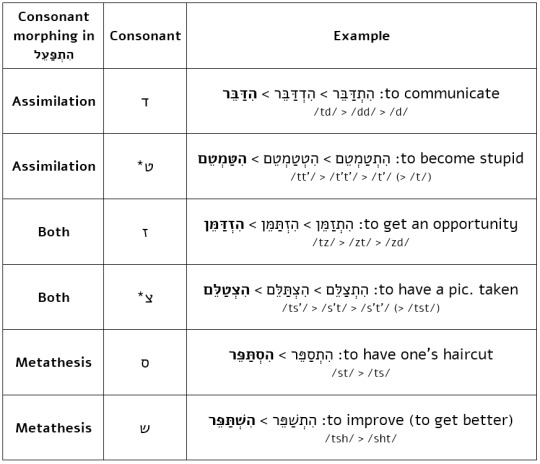
ט and צ, marked with an asterisk, are quite complicated. You probably noticed I wrote them as /t’/ and /s’/ instead of plain /t/ and /ts/. This is because they weren’t all pronounced as they are today. If you recall, in lesson 1 I recalled many “historical reasons” that there are so many homophones in Hebrew. This is because over its history in the diaspora, certain communities (namely Ashkenazi and Sephardi Jews) merged many of those consonants, and in modern times, since the Sephardi reading of the Bible was adopted as the pronunciation of Hebrew after its revival - these mergers stuck. Among these, Sephardim and Ashkenazim merges ת and ט. Originally it was pronounced as an “emphatic” consonant, meaning it came more “from the throat” (If you are familiar with Arabic, it was pronounced like Arabic ط): hence I wrote it as /t’/.
צ was pronounced differently between communities, but originally it was pronounced similarly to ט, “from the throat” (like Arabic ص). However, the Ashkenazi pronunciation /ts/, as if it were a combination of ס and ת, stuck in Modern Hebrew.
The different consonant morphings happened centuries before the Jewish diaspora, so the consonants were still pronounced as they were originally. Back then it was easier to pronounce /s’t’/ than /s’t/ because both consonants were emphatic, so it morphed. These days it seems pointless, since ט and ת have the same phonetic value, but the correct spelling is nonetheless הִצְטַלֵּם. Many speakers make the mistake of writing הִצְתַּלֵּם, but it is just that - a spelling mistake.
Past Tense
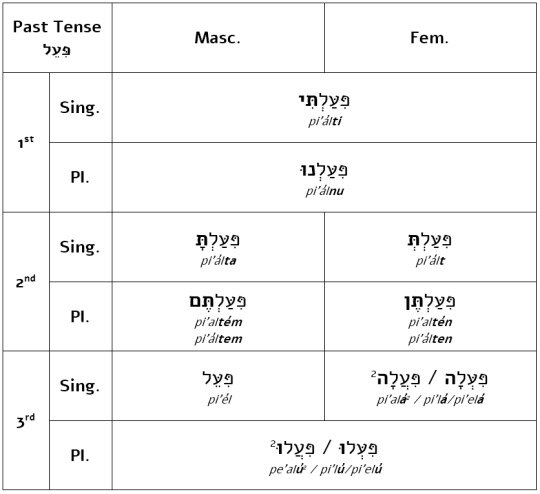
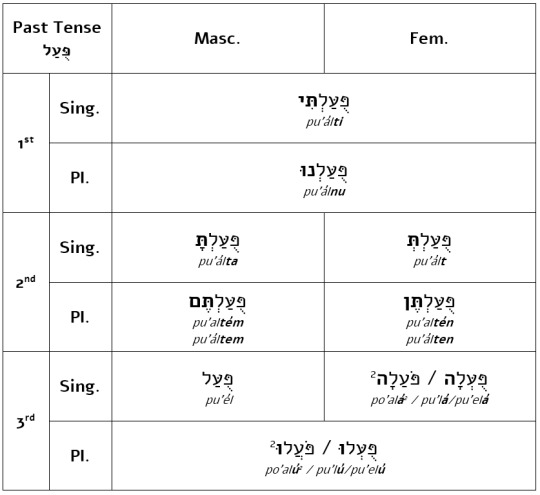
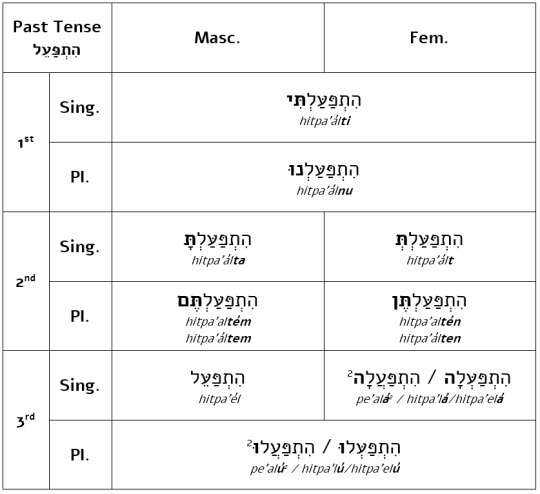
Verbs marked with 2, as usual, undergo vowel reduction that turns a shva into a hataf /a/ (סֲ) under certain guttural letters, but you might have noticed something particularly strange in these verbs under the פֻּעַל stem - the characteristic /u/ (סֻ) changes to an /o/ (סֹ). This is because of a phenomenon in Hebrew called “dagesh compensation,” תַּשְׁלוּם דָּגֶשׁ tashlum dagesh, where the vowel before a guttural letter with a dagesh gets intensified to accommodate the reduction of the dagesh.
Dagesh compensation typically happens in the double stems, however it occurs in נִפְעַל as well, in future tense conjugations. It goes as follows:
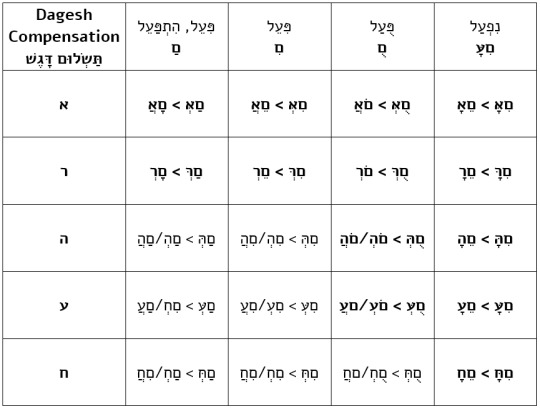
I marked where compensation occurs in bold, because it does not occur before every guttural letter.
Take note that although the vowel point changes in the first column, םַ, the pronunciation actually stays the same.
Furthermore, each letter handles vowel reduction differently, as you can see. א always takes a hataf (םֱ, םֲ, םֳ) instead of a shva, ר never, and under ה, ע, ח whether the shva changes to a hataf changes on a case to case basis. Keep in mind that this also means the pronunciation is different: when the reduced vowel is rendered as a םְ it can be pronounced either as a /e/ or as no vowel, depending on the following consonant; when it is rendered as a hataf it can be pronounced either as /a/, /e/ or /o/, depending on the identity of the hataf.
If the guttural vowel has any vowel other than םְ, it is conserved and does not change in spite of the vowel intensification (a can seen in the last column, נִפְעַל).
I didn’t write the vowel forms in the tables according to the correct compensated forms (due to the 2nd radical of פ־ע־ל being a guttural) because that would mean a very messy table. I expect you to think for yourselves and write for yourself what the correct forms of the verbs, taking dagesh compensation into account. It isn’t that hard actually, just knowing where /i/ becomes /e/ and when /u/ becomes /o/. (I did, however, include two forms when the vowel on the 2nd radical gets reduced, because that’s what I’ve been doing until now and I like consistency)
Future Tense
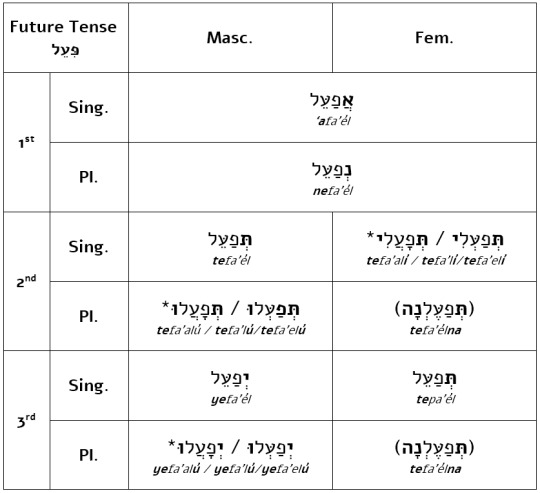
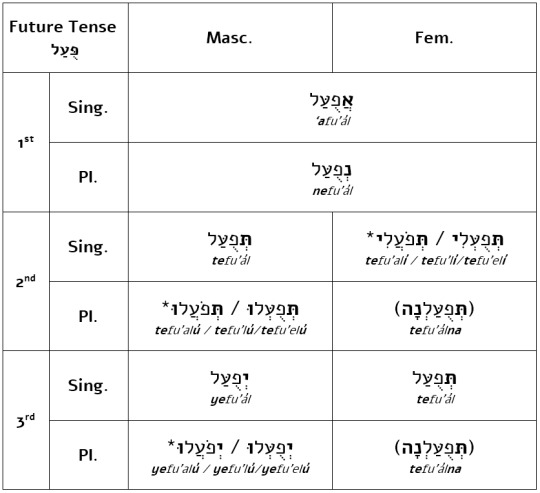
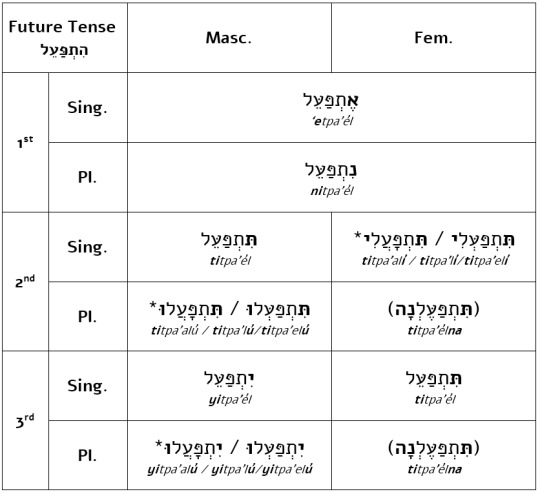
1st person conjugations have a different bowel of the prefix (א־) because the vowel on the א either changes to a hataf (אְ > אֲ) or it intensifies (אִ > אֶ).
Luckily that’s all There needs to be explained here. Everything peculiar here, you should already know the answer to from previous lessons
That’s it!
Next lessons I’ll be delving into the present tense and infinitives. Until then - keep your eyes peeled for more lessons!
See you next time :)
#Hebrew#Hebrew language#Learn Hebrew#hebrew resources#hebrew study#ivrit#verbs#עברית#שפה עברית#לומדים עברית#שיעור עברית#Hebrew Lesson#hebrewing
52 notes
·
View notes
Photo
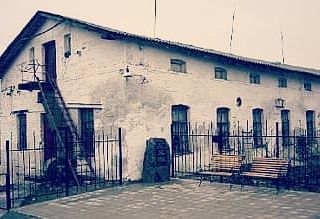
( אות קפז - חיי מוהר"ן ) " קדֶם שֶׁיָּצָא ( רבינו נחמן ) מִבְּרֶסְלַב לְאוּמֶין לְהִסְתַּלֵּק שָׁם... בָּעֵת שֶׁיָּצָא מִפֶּתַח הַבַּיִת וְלַחוּץ לַעֲלוֹת עַל הָעֲגָלָה עָמַד אֵצֶל הַמְּזוּזָה וְהִנִּיחַ יָדוֹ עַל הַמְּזוּזָה עָנָה וְאָמַר לְהָעוֹלָם : "תִּרְאוּ לְהִתְקַבֵּץ יַחַד וּלְהִתְפַּלֵּל יַחַד , כִּי אִם תִּתְפַּלְּלוּ בְּכַוָּנָה אוּלַי תּוּכְלוּ לְהַמְשִׁיךְ אוֹתִי לְכָאן עוֹד הַפָּעַם ... ... ... " https://www.instagram.com/p/BqY_MJAnt_B/?utm_source=ig_tumblr_share&igshid=1t3ckx4kjhn77
0 notes
Text
Scripture of the Day: February 16th, 2017
Scripture of the Day: February 16th, 2017
Scripture of the Day: Ecclesiastes 2: 1-11 Highlighted are word(s) that (I find) have interesting definitions. H8057 שִׂמְחָה śimchâh sim-khaw’ From H8056; blithesomeness or glee, (religious or festival): – X exceeding (-ly), gladness, joy (-fulness), mirth, pleasure, rejoice (-ing). H5975 עָמַד ‛âmad aw-mad’ A primitive root; to…
View On WordPress
#Alternative#Architecture#Christ#Christianity#Christians#Church#Jesus Christ#Lifestyle#Love#News#NYC#Religion#Spirit#Spirituality#Truth#USA#World
0 notes
Text
Hebrew Primer Unit ה Exercise ד
Pick the correct form of the verb and translate
.דָּוִד (שָׁמַע, שָׁמְעָה) .רוּת (שָׁמַע, שָׁמְעָה) .הַבֵּן (זָכַר, זָכְרָה) .בָּת (שָׁמַר, שָׁמְרָה) .נַעַר (הָלַךְ, הָלְכָה) .הַמִּשְׁפָּחָה (מָלַךְ, מָלְכָה) .הַבַּיִת (עָמַד, עָמְדָה) .אִישׁ (מָלַךְ, מָלְכָה)
1 note
·
View note
Text
Hebrew Primer Unit ה Exercise ב
Read aloud and translate
הָלַךְ, הָלְכָה עָמַד, עָמְדָה שָׁמַר, שָׁמְרָה שָׁמַע, שָׁמְעָה זָכַר, זָכְרָה מָלַךְ, מָלְכָה
PREV/FIRST/NEXT
1 note
·
View note
Text
Hebrew primer Unit ד Exercise ו
Read aloud and translate these phrases.
.אַבְרָהָם שָׁמַע דָּבָר .מָלַךְ דָּוִד .זָכַר הַנַּעַר דָּבָר .בֵּן שָׁמַר .עָמַד הַמֶּלֶךְ .זָכַר הוּא בַּיִת .שָׁמַע הָאִישׁ דָּבָר .הַבַּיִת עָמַד .הַמֶּלֶךְ מָלַךְ
NEXT
0 notes